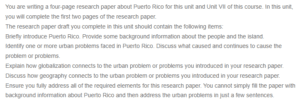Urban Problems in Puerto Rico
Introduction
Puerto Rico is a group of Islands bordered by the Caribbean Sea and the Atlantic Ocean. The people of Puerto Rico have a mix of cultural influences, including the Spanish and the US. Also, the Afro-Caribbean culture is a significant cultural influence in the region. The United States significantly influences the Island’s economic and social status. That is partly attributable to the significant presence of US manufacturing firms and military installations. Despite the recent mushrooming political controversy, most people in Puerto Rico prefer the continuation of commonwealth-level relationships with the US. Geographically, Puerto Rico is largely mountainous, with most of the land being hilly terrain.
Urban Problems in Puerto Rico
One of the major problems facing Puerto Rico is unplanned urban sprawl. The transformation from an agricultural-based economy to an industrial economy has led most of the population to move to urban centers (Martinuzzi et al., 2007). With ineffectual urban planning, people occupy spaces without effective landscaping to ensure proper settlement. Besides, political influences have partly contributed to the urban sprawl in Puerto Rico. Puerto Rico has 78 municipalities, each with one small town or city (Martinuzzi et al., 2007). The urban centers are situated towards coastal plains and near roads, which continues to worsen the situation. As such, urban areas occupy just a small part of Puerto Rico’s land, yet most people live in these urban areas. Without effective urban planning, urban sprawl contributes to high energy costs, congestion, and pollution.
Another problem facing Puerto Rico is endemic urban poverty. While poverty in Puerto Rico did not begin with urbanization, the introduction of a capitalist economy has worsened the situation in the country (Pimentel, 2008). Such poverty may be described as self-reproduced. As the country industrializes, more people feel they stand a better chance to improve their economic status in cities than in rural areas. However, these people are offered low wages in cities which cannot sustain their economic standards (Pimentel, 2008). Besides, this cohort of the population lives in areas where they cannot access some of the basic amenities, leading to induced poverty. Urban poverty and inequalities in Puerto Rico are attributable to the introduction of a capitalist economy and the class structure.
The Relationship between Globalization and Puerto Rico’s Urban Problems
According to Duchesne (2006), globalization is partly to blame for Puerto Rico’s endemic poverty situation. Since Puerto Rico is not a fully sovereign state, the US partly controls its economy through Congress. To that end, the US has introduced free trade area policies that allow US multinationals to operate on the Island. Such policies imply that the people of Puerto Rico may only work in these American companies since local entrepreneurship is pushed to the periphery.
Also, the dependency theory explains why poverty levels have gone up in Puerto Rico. As globalization takes root, foreign capital flows more freely into the economy, unlike in the past (Martinuzzi et al., 2007). That has led to the sidelining of the subsistence economy as the mainstream economy takes root. In the long run, Puerto Ricans migrate to cities, leading to urban sprawl.
How Geography Leads to the Urban Sprawl
As stated earlier, Puerto has a hilly terrain. With a hilly terrain, urbanization may only occur in narrow coastal plains (Greiner, 2014). Cities and towns are also mostly concentrated in terrains where it is easier to construct roads. The sloppy terrains were traditionally used for farming, but that is not the case as the country industrializes. As more people move to towns, they have to settle in a limited area, leading to congestion.
References
Duchesne, R. (2006). Globalization, the Industrialization of Puerto Rico and the Limits of Dependency Theory. Journal Für Entwicklungspolitik, 22(1), 55–83. https://doi.org/10.20446/jep-2414-3197-22-1-55
Greiner, A. L. (2014). Visualizing human geography. Wiley-Blackwell.
Martinuzzi, S., Gould, W. A., & Ramos González, O. M. (2007). Land development, land use, and urban sprawl in Puerto Rico integrating remote sensing and population census data. Landscape and Urban Planning, 79(3-4), 288–297. https://doi.org/10.1016/j.landurbplan.2006.02.014
Pimentel, F. (2008). Poverty, culture and social capital in Puerto Rican urban communities. Centro Journal, 20(1), 230-245.
ORDER A PLAGIARISM-FREE PAPER HERE
We’ll write everything from scratch
Question

Urban Problems in Puerto Rico
You are writing a four-page research paper about Puerto Rico for this unit and Unit VII of this course. In this unit, you will complete the first two pages of the research paper.
The research paper draft you complete in this unit should contain the following items:
Briefly introduce Puerto Rico. Provide some background information about the people and the island.
Identify one or more urban problems faced in Puerto Rico. Discuss what caused and continues to cause the problem or problems.
Explain how globalization connects to the urban problem or problems you introduced in your research paper.
Discuss how geography connects to the urban problem or problems you introduced in your research paper.
Ensure you fully address all of the required elements for this research paper. You cannot simply fill the paper with background information about Puerto Rico and then address the urban problems in just a few sentences.

